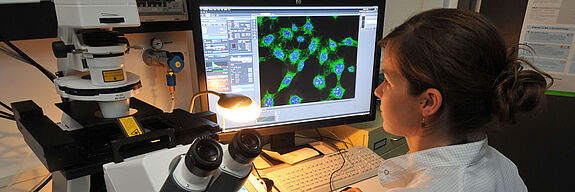Areas of investigation/research focus
The human brain exists of billions of cells, which represent primarily two basic cell types neurons and glia. Of those neurons are the key players in the brain as they are the information messengers transmitting signals throughout the brain. The main communication unit is thereby the synapse. It is a small cellular structure where information is transferred between adjacent neurons. Proper neuron and synapse function is not possible without the backing of glia support cells like astrocytes. The cooperation between neurons, synapses and astrocytes is crucial for proper CNS development, neuron and synapse function. Their interaction is mediated amongst others through signaling factors, which become mainly secreted from astrocytes but also neurons. For this reason a malfunction of astrocytes has been linked to neurodevelopmental and neurodegenerative diseases.
The presynaptic active zone protein Piccolo is of particular interest for us, as mutations in its gene have been found in patients with Pontocerebellar Hypoplasia type 3 (PCH3), an early onset neurodegenerative disease in children. PCH3 results in progressive atrophy of parts of the brain, particularly the cerebellum and brainstem and leads to developmental delay, motor defects, and intellectual impairments, with most children dying early in childhood. To this day we understand very little how the loss of function of a synaptic protein like Piccolo contributes to the observed multiple symptoms in affected children.
Fortunately we have a Piccolo knockout rat model in the lab, which is a suitable animal model to study the mechanisms leading to PCH3 as it resembles most symptoms seen in PCH3 patients – smaller cerebellum and brainstem, motor defects and seizures. Interestingly recent preliminary data indicate a connection between Piccolo function, astrocyte function and the onset of the neurodegenerative diseases PCH3.
For this reason we will focus our research in the future on the interplay between synapses, astrocytes and Piccolo and its importance for the progression of neurodegenerative diseases like PCH3. We will use primary cell cultures, state-of-the-art microscopy and biochemistry methods furthermore we will establish a human PCH3 disease model using human iPSCs and CRISPR/Cas9 gene editing techniques to better understand Piccolo's contribution to PCH3.


